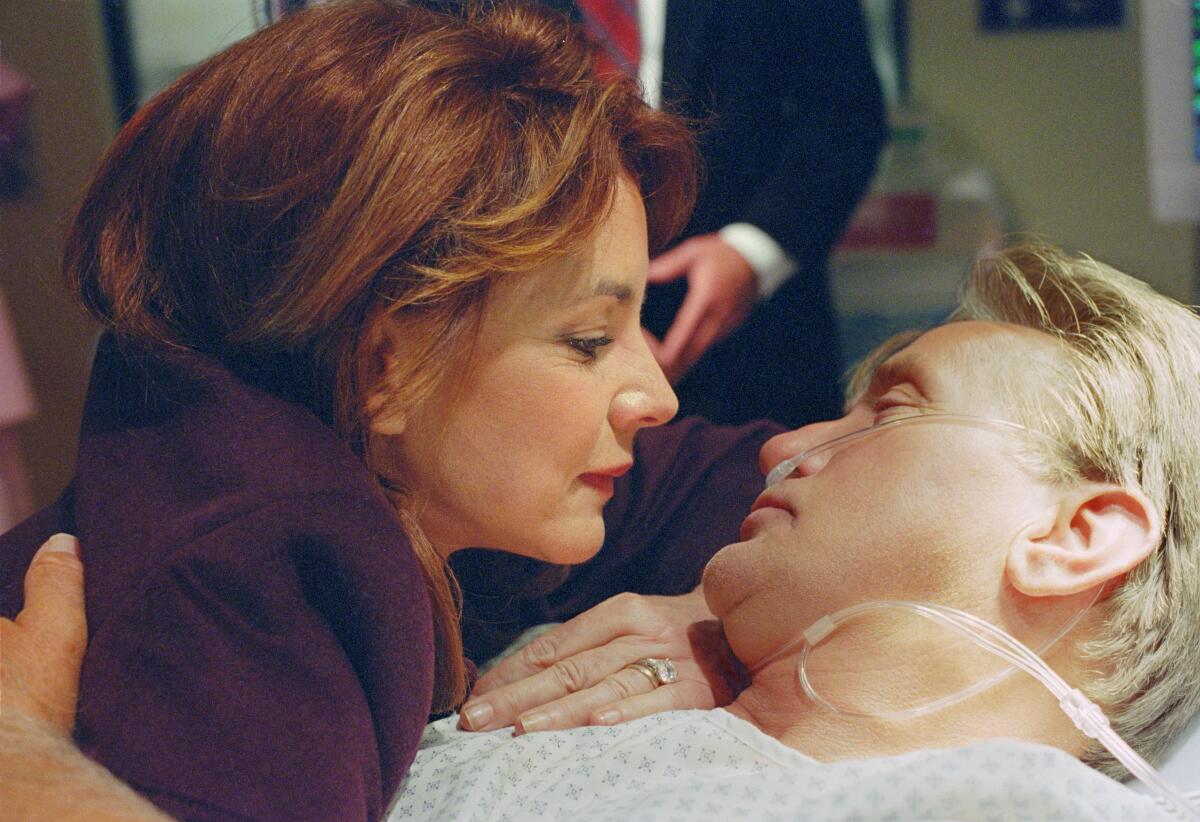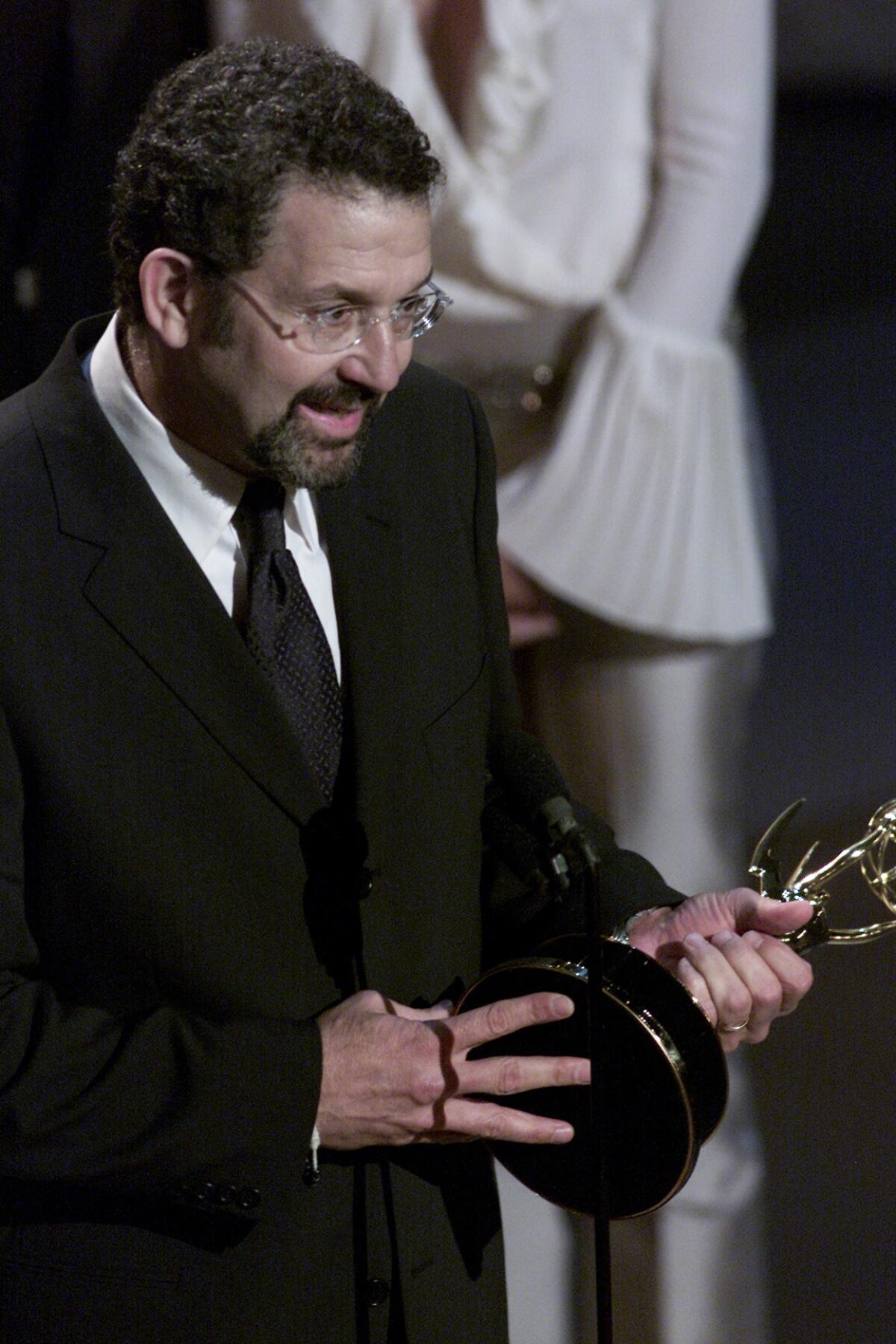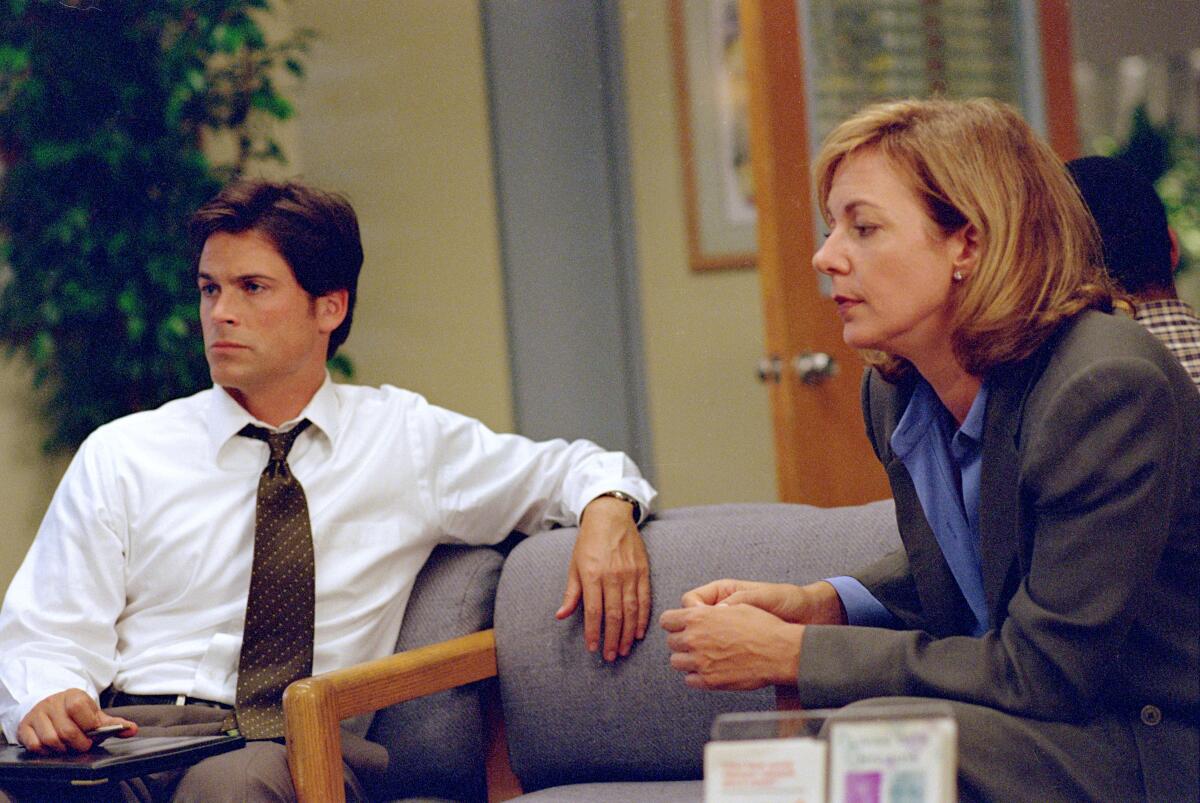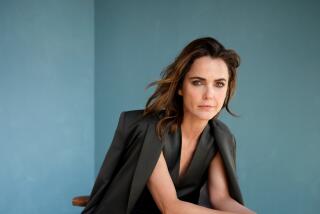How ‘The West Wing’s’ ‘difficult’ assassination-attempt episodes were pulled off

In “Inside the Episode,” writers and directors reflect on the making of their Emmy-winning episodes.
Just as with real-life assassination attempts, to really understand the power of “The West Wing’s” two-part Season 2 premiere, “In the Shadow of Two Gunmen,” requires a look back at the actions before the attack. In this case, it would be the NBC show’s Season 1 finale, “What Kind of Day Has It Been,” a cliffhanger that, in the nascent days of prestige-TV watching and analysis from fan sites like Television Without Pity, meant so-called Wingnuts spent a summer obsessing over their VCR recordings like they were the Zapruder film. Who of President Bartlet’s (Martin Sheen) employees was taken down by surprise gunfire? Was it the commander in chief himself? His daughter Zoey (Elisabeth Moss)? Her boyfriend, Charlie (Dulé Hill)? What about the footage of deputy communications director Sam Seaborn (Rob Lowe) rushing as press secretary C.J. Cregg (Allison Janney) is pushed to the ground? And where is communications director Toby Ziegler (Richard Schiff)?
“West Wing” executive producer Thomas Schlamme helmed all three episodes, winning the Emmy for directing for a drama series for the Season 2 doubleheader. He’d also share in the show’s drama series win that year, which would end up being its second of four consecutive victories in the category.
But directing both the closing and opening episodes didn’t necessarily make his job any easier.
Unlike “The Princess Bride” and “Star Trek” reunions, “The West Wing” special is not expressly partisan. But it confronts President Trump and the GOP nonetheless.
“When we were going into the finale of Season 1, we knew that this was not an assassination to the president,” Schlamme recalls. However, “What we didn’t know, and what Aaron [Sorkin, the series’ creator] didn’t know — and was so kind to inform me before we started shooting — was who would get hit, if anyone. But, probably, somebody would get shot.”
For Schlamme and his crew, this meant grabbing fragments of footage to be used in Season 1’s chaotic end montage when they filmed at Washington, D.C.’s Newseum and then returning to the scene of the crime several months later to re-create the events to coincide with Sorkin’s scripts for the Season 2 premiere.
Schlamme also didn’t know just how prescient these episodes would be. “West Wing’s” second season would premiere in September 2000, about a year and a half after the Columbine High School massacre and two months before a heated U.S. presidential race that went all the way up to the Supreme Court. But it wasn’t eligible for Emmy consideration until 2001. Schlamme and other winners at that year’s Emmys would not be acknowledged until November — at a ceremony that had to be rescheduled twice in the wake of the Sept. 11 terrorist attacks.
“Aaron has often said we weren’t forcing people to eat vegetables,” the director-producer says. “First and foremost, it’s about what is good drama and good entertainment and a riveting piece of theater. But underneath there … I think I was very focused on domestic terrorism and about this rage that now is just so incredibly prevalent in our country.”
In an interview that has been edited and condensed, Schlamme spent about an hour of yet another election year reflecting with The Times about these pivotal episodes.

Was the Season 1 finale intended to be a reference to the infamous “Who Shot J.R.?” cliffhanger from the 1980s nighttime soap opera “Dallas”?
It literally was not part of the conversation. It was not, “Oh, we need a cliffhanger like they did 20 years earlier on ‘Dallas.’” There was no relationship between those two shows, no relationship in the way that Aaron works. In fact, we were rather surprised with the idea that it was this incredible cliffhanger. We knew it was a big moment and we wanted a big moment.
But what I remember most was having a conversation with Aaron. Because what we were surprised about, in the first season of the show, is the mail that we would get that was unbelievably supportive of the show. We would get letters from Republicans, and they would go, “We really hate your politics, but we love the show and we love these people.” They really did get the idea that we weren’t trying to force a political agenda down anybody’s throat.
The only hate mail that we got was after Dulé and Elisabeth’s characters kissed onscreen. I think it was 1999, and we were shocked that we did get a lot of, “How dare this African American, basically, assistant to the president, have this romantic affair with the daughter of a white president?”
I think that’s what set in motion the idea of, “What if somebody wanted to shoot Charlie?” not, “We should have an assassination toward the president.” That’s about all we knew when we were going into the finale of Season 1.
It turns out that both Bartlet and Bradley Whitford’s Josh Lyman, the deputy chief of staff, are shot. You said you didn’t know who would get shot. But did you know if they would survive?
First of all, Brad and Aaron are very close friends. He wrote the part for Brad Whitford. So I don’t think that he would have killed him in the very first year.
But look, there were deaths on “The West Wing.” There weren’t that many, but there were deaths. It was never with the thought of, “Oh, we’re going to kill this character [for ratings or shock value].” It was always to drive some sort of story for a reason.
Brad’s mother, [however], didn’t know, and was frightened to death that not only did you shoot Brad but that he’s not going to be on the show anymore.
Now we have a stereotype, for better or worse, of what a domestic terrorist “looks” like. Were there conversations then about what the shooters would look like? They are young, white men with buzz cuts.
Strangely enough, we had cast, I think, one of them earlier in an episode as just an extra in the background. And when we then started talking about whether it would be Charlie who would be the target, we went, “Remember that extra?”
If the season finale and premiere were shot at different times, how did you go back and match what you’d done before?
Difficulty is the word. If we had known everything, and it had been contemporary television, we would have shot at least that part of the next episode right there.
For me, it was, No. 1, securing the location, and that was the Newseum. So we had to let them know that we would have to come back. We only had a finite amount of time there. … We had to be out of there, pulled plug and everything, by 6 in the morning when the sun was coming up. When Richard is finding Brad, you’ll see that the sky is somewhat bluer. We didn’t quite have the digital correcting software that we do now.
We were loading the trucks, we were told we had to leave and that we could not shoot anymore. We started the evening with this big production and we ended with guerrilla filmmaking. It was just myself, the [director of photography], Brad and Richard and a couple of extras. I didn’t call action; I didn’t do anything because they didn’t know we were shooting.

In a press briefing after the shooting, Janney’s C.J. makes a statement about all the people who did die from gun violence the night of the assassination attempt. Were you trying to make a political statement?
That’s a very powerful speech that Allison gives [and one] that you could still hold up [as to why] we need some legislation about gun control. We weren’t trying to make a statement. It’s just that’s what that press secretary would say about what happened that night to [shooting victims] beside the most protected person in the world.
The scene where Charlie finds out that he was the intended victim is very slow and deliberate.
If you look at the choreography of “The West Wing,” it was always set up so that it would move and move and move. And then, even if it was just to get coffee, everything would come to a little bit of a halt because it’s a piece of information you need.
And by the way, this goes to the theory that you don’t need a lot of dialogue, especially when it’s Aaron, who writes a lot of dialogue. I think Dulé Hill, in that scene where he’s told, is stunningly brilliant. I think he has three “OKs.” And each one is filled with something else that he [is processing].
This is also an early episode that points to something that will be a bigger plot point later: The president has multiple sclerosis. The first lady (Stockard Channing) is a medical doctor and shares this little-known fact with his anesthesiologist in a sort of robotic, “come what may” way: This is the information you need; do what you will with it later.
There’s this frenetic energy when she’s running out of the White House. Also, a fun little detail here: The [man playing the] head of her security detail is a man named Willie Gault, who played for the Los Angeles Raiders and was an Olympic gold medalist. So he is literally one of the fastest human beings in the world. My only direction to Willie was, “Can you just slow down a little bit because you’re so ahead of everybody else?”
But Stockard and I talked and [the direction was], “Find your daughter. And from that point on, you’re a medical professional who is in a hospital with a critical patient.”
It’s really interesting because it’s so disconnected. … It’s just business. And because Stockard’s so brilliant under there, you’re believing, “Holy s—, your husband was just shot. But she’s got to be this doctor.”
I shot that so you could see the president in the background. It’s not quite an over-the-shoulder of the [anesthesiologist]. It’s all on Stockard. I don’t care about the doctor’s reaction to this. He means nothing to me in storytelling.
You were honored with these Emmys a few years after your wife, actor Christine Lahti, made her famous Golden Globes acceptance speech after her award was announced while she was in the restroom. Do you give each other notes on award speeches?
No. Well, I’m sure Christine has gone over her speeches with me. Not because she relies on me. That’s just who she is; she’s very open.
I very seldom ever do that. That’s not an asset. They’re also embarrassing to me that I have to write them before I [might win] them.
But I spent four years being president of the Directors Guild. I’ve worked on negotiations. I’ve also given speeches, as well as Christine, politically and elsewhere. We will absolutely share that with each other.
But if we go to an awards show, I just make sure that Christine doesn’t leave the table.
More to Read
From the Oscars to the Emmys.
Get the Envelope newsletter for exclusive awards season coverage, behind-the-scenes stories from the Envelope podcast and columnist Glenn Whipp’s must-read analysis.
You may occasionally receive promotional content from the Los Angeles Times.







